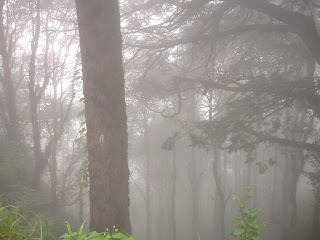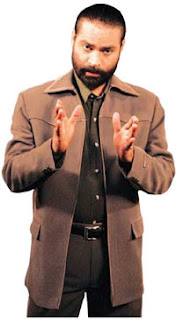
Mukteshwar perched at 7,500 ft in the lower Himalayas is not a hill station, nor is it on the way to anything of significance. It just is. Off the map, and unconcerned. Kumaoun has deeper woods and greater diversity of fauna than most parts of India. Being here is a treat in itself.
We leave Delhi excited at the thoughts of deep Deodar woods, heady fresh mountain air and that unique quiet you find among forested slopes. The road from Delhi takes only seven hours. We add a couple of hours, making allowance for a dip at the holy Ganga at Gharmukteshwar. A must do is to take a boat ride here looking for the elusive Ganges dolphin. Alas, elusive it remains, because the river pristine as it appears, is polluted by the nearby sugar mills.
Back in the 4x4 and the journey is smooth once you leave Uttar Pradesh behind. However, the saving grace of UP is the lunch at Rampur. This former fiefdom of the famous Nawab Ahmed Ali Khan Bahadur is known for its great dog breed — the Rampur hound, a unique Rampuri designed dagger and exquisite food. We sample with relish a big spread of kebabs — succulent as they come. Also on offer is distinctive Haleem, a lentils and mutton combination cooked with clarified butter over large copper pots overnight. Slow food movement may be catching on in the rest of the world but here it’s a way of life.
An hour from Rampur racing through a teak and sal forest, starts the climb. We pass the pleasant Lake District of Bhimtal. Two more hours through meandering greens and we arrive at the hotel Win Cliff, elevated above a high ridge overlooking Mukteshwar. Red bricks, minimalist architecture with green potted plants, and wood panels blend in with the surroundings.
Mukteshwar has a unique offering for those who are serious rock climbers. At the edge of the western rock end of this tiny town, the rock face is jagged, with sheer drops of up to 600 feet. A bunch of mountaineering enthusiasts run this camp. With a little bit of training and a whole lot more of enthusiasm, you can climb about, securely hooked from a line. The cool mountain air makes this adventure a little easy to bear. However undertake it only of you derive joys from making the body dog tired while negotiating sheer drops that even with a secure hooked line could cause serious damage should you miss a footing. The rock formations here are so famous that the government is seriously thinking of a year-round professional camp from 2008.
The next morning we meet the owner of the hotel, who, to our surprise, is an IIM graduate. This is absolutely the place to stay in Mukteshwar. The view below is of valleys sloping down a good 2,000 ft and more. There are views of farms and hamlets, and the occasional jungle fowl cackling noisily away.
Directly opposite in the far horizon is the great Nanda Devi ice face. This is a massive peak at over 21,000 ft that makes even Mukteshwar look but a hillock. On a clear day this astonishing mountain is an in-your-face encounter with the great Himalayas, and one is unlikely to ever forget it. This, you say to yourself, is it. The view was the reason we did not visit just another hill station. Alas, mists encircle the patron goddess of Uttrakhand and before we know it, she has disappeared — enveloped by the Himalayas.
The next day is for a short ride to the hunting lodge of the legendry Jim Corbett. The tales immortalised in the book Man-eaters of Kumaoun are based largely in these parts. It is in poor shape and has little by the way of memorabilia about the great man. However, the setting is so picture perfect it makes up for all the shortcomings. Once here you can choose from a myriad bunch of mountain roads that the goatherds take for pasture land below. We pack a picnic lunch and walk six kilometers to reach a wooded meadow. Delhi is so far out of reach it’s almost forgotten!
Another must visit, an ancient Shiv Temple from which the town gets it name. This is the abode of the free god. It has a curious intensity, a peculiar, almost primeval pull. The old sadhu is almost out of a coffee table book. Long matted locks and lots of vibhuti. He tells me that we have met in a previous life and that I was a penniless wanderer. Guess not much has changed in this life either. A long discussion on the meaning of life and death, on tracing lineages, on the concept of time follows. A most fulfilling three quarters of an hour of matters spiritual.
From Lord Shiva to Corbett, from ecological beauty and sheer magnificence of the great Nanda Devi, from walks in wooded nooks to enveloping silence of a glittering equinox, Mukteshwar offers all this and a lot more. So go over, stay and generally do nothing much else while there. Get away to sample a bit of heaven while it lasts. We bumped into two “property developers” just as we got ready to depart.
We leave Delhi excited at the thoughts of deep Deodar woods, heady fresh mountain air and that unique quiet you find among forested slopes. The road from Delhi takes only seven hours. We add a couple of hours, making allowance for a dip at the holy Ganga at Gharmukteshwar. A must do is to take a boat ride here looking for the elusive Ganges dolphin. Alas, elusive it remains, because the river pristine as it appears, is polluted by the nearby sugar mills.
Back in the 4x4 and the journey is smooth once you leave Uttar Pradesh behind. However, the saving grace of UP is the lunch at Rampur. This former fiefdom of the famous Nawab Ahmed Ali Khan Bahadur is known for its great dog breed — the Rampur hound, a unique Rampuri designed dagger and exquisite food. We sample with relish a big spread of kebabs — succulent as they come. Also on offer is distinctive Haleem, a lentils and mutton combination cooked with clarified butter over large copper pots overnight. Slow food movement may be catching on in the rest of the world but here it’s a way of life.
An hour from Rampur racing through a teak and sal forest, starts the climb. We pass the pleasant Lake District of Bhimtal. Two more hours through meandering greens and we arrive at the hotel Win Cliff, elevated above a high ridge overlooking Mukteshwar. Red bricks, minimalist architecture with green potted plants, and wood panels blend in with the surroundings.
Mukteshwar has a unique offering for those who are serious rock climbers. At the edge of the western rock end of this tiny town, the rock face is jagged, with sheer drops of up to 600 feet. A bunch of mountaineering enthusiasts run this camp. With a little bit of training and a whole lot more of enthusiasm, you can climb about, securely hooked from a line. The cool mountain air makes this adventure a little easy to bear. However undertake it only of you derive joys from making the body dog tired while negotiating sheer drops that even with a secure hooked line could cause serious damage should you miss a footing. The rock formations here are so famous that the government is seriously thinking of a year-round professional camp from 2008.
The next morning we meet the owner of the hotel, who, to our surprise, is an IIM graduate. This is absolutely the place to stay in Mukteshwar. The view below is of valleys sloping down a good 2,000 ft and more. There are views of farms and hamlets, and the occasional jungle fowl cackling noisily away.
Directly opposite in the far horizon is the great Nanda Devi ice face. This is a massive peak at over 21,000 ft that makes even Mukteshwar look but a hillock. On a clear day this astonishing mountain is an in-your-face encounter with the great Himalayas, and one is unlikely to ever forget it. This, you say to yourself, is it. The view was the reason we did not visit just another hill station. Alas, mists encircle the patron goddess of Uttrakhand and before we know it, she has disappeared — enveloped by the Himalayas.
The next day is for a short ride to the hunting lodge of the legendry Jim Corbett. The tales immortalised in the book Man-eaters of Kumaoun are based largely in these parts. It is in poor shape and has little by the way of memorabilia about the great man. However, the setting is so picture perfect it makes up for all the shortcomings. Once here you can choose from a myriad bunch of mountain roads that the goatherds take for pasture land below. We pack a picnic lunch and walk six kilometers to reach a wooded meadow. Delhi is so far out of reach it’s almost forgotten!
Another must visit, an ancient Shiv Temple from which the town gets it name. This is the abode of the free god. It has a curious intensity, a peculiar, almost primeval pull. The old sadhu is almost out of a coffee table book. Long matted locks and lots of vibhuti. He tells me that we have met in a previous life and that I was a penniless wanderer. Guess not much has changed in this life either. A long discussion on the meaning of life and death, on tracing lineages, on the concept of time follows. A most fulfilling three quarters of an hour of matters spiritual.
From Lord Shiva to Corbett, from ecological beauty and sheer magnificence of the great Nanda Devi, from walks in wooded nooks to enveloping silence of a glittering equinox, Mukteshwar offers all this and a lot more. So go over, stay and generally do nothing much else while there. Get away to sample a bit of heaven while it lasts. We bumped into two “property developers” just as we got ready to depart.






